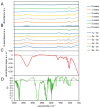The Impact of Abiotic and Biotic Conditions for Degradation Behaviors of Common Biodegradable Products in Stabilized Composts
- PMID: 38930317
- PMCID: PMC11205212
- DOI: 10.3390/ma17122948
The Impact of Abiotic and Biotic Conditions for Degradation Behaviors of Common Biodegradable Products in Stabilized Composts
Abstract
This work examines the influence of the degradation behaviors of biotic and abiotic conditions on three types of biodegradable products: cups from PLA and from cellulose, and plates from sugarcane. The main objective of this study was to evaluate if biodegradable products can be degraded in composts that were stabilized by backyard composting. Furthermore, the impact of crucial abiotic parameters (temperature and pH) for the degradation behaviors process was investigated. The changes in the biopolymers were analyzed by FTIR spectroscopy. This work confirmed that abiotic and biotic conditions are important for an effective disintegration of the investigated biodegradable products. Under abiotic conditions, the degradation behaviors of PLA were observable under both tested temperature (38 and 59 °C) conditions, but only at the higher temperature was complete disintegration observed after 6 weeks of incubation in mature compost. Moreover, our research shows that some biodegradable products made from cellulose also need additional attention, especially with respect to incorporated additives, as composting could be altered and optimal conditions in composting may not be achieved. This study shows that the disintegration of biodegradable products is a comprehensive process and requires detailed evaluation during composting. The results also showed that biodegradable products can also be degraded post composting and that microplastic pollution from biodegradable polymers in soil may be removed by simple physical treatments.
Keywords: FTIR—Fourier-transform infrared spectroscopy; PBAT—polybutylene adipate terephthalate; PBS—polybutylene succinate; PLA—polylactic acid.
Conflict of interest statement
The authors declare no conflict of interest.
Figures









References
LinkOut - more resources
Full Text Sources

